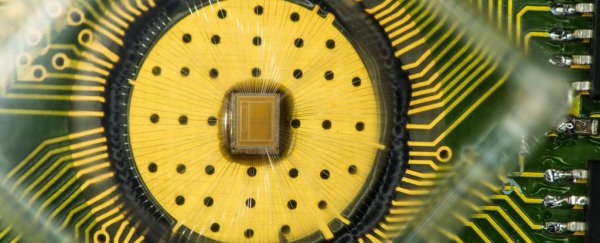Scientists at IBM Research have demonstrated a new level of efficiency for data storage with optical memory, using a storage format called phase-change memory (PCM) to store 3 bits of data per cell for the first time.
While PCM is nothing new and has actually existed as a memory format for decades, until now it's been limited to storing 1 or 2 bits of data per PCM cell. But IBM's new achievement is significant because in increasing the storage capacity of each cell up to 3 bits, it will make PCM – which is dramatically faster than flash memory – vastly more cost-effective.
What does this mean for you? According to IBM, PCM could soon be used for memory in all sorts of devices, from personal gadgets like smartphones and notebooks, to powering the data centres that give us things like email and Facebook.
"Phase-change memory is the first instantiation of a universal memory with properties of both DRAM and flash, thus answering one of the grand challenges of our industry," said lead researcher Haris Pozidis from IBM Research in Zurich, Switzerland. "Reaching 3 bits per cell is a significant milestone because at this density the cost of PCM will be significantly less than DRAM and closer to flash."
Most devices like smartphones and notebooks currently use a combination of dynamic random-access memory (DRAM) and flash memory, with the former acting as active memory while devices are on, and the latter being used to store data long-term (off or on).
One of the factors that has prevented PCM taking off up until now has been its cost, but aside from the economics, it offers considerable advantages over these alternatives.
Unlike DRAM, which is extremely fast but also rather expensive, PCM doesn't lose data when devices are powered off. And while PCM isn't quite as fast as DRAM – ranging between five to 10 times slower – it's dramatically faster than flash memory. How much faster depends on who you ask, but common estimates suggest it's up to 70 times faster, while theoretical applications put it at hundreds of times faster.
As IBM points out, another advantage of PCM is that the memory can survive at least 10 million write cycles, meaning hypothetically you could be getting a life-time warranty with the storage. Flash memory, on the other hand, only lasts around 3,000 write cycles before degrading.
PCM works by applying an electrical current to the memory cells on a chip, which changes the cell from an amorphous (unstructured) state to a crystalline (structured) state. The state can then be read by a computer as a bit, either a 0 (amorphous) or a 1 (crystalline).
What the researchers have done here is refine the temperature controls when the current passes through and heats up the cells, letting up to 3 bits now be stored on each, and it's this capacity gain that could enable PCM to finally make commercial sense as an attractive option somewhere in between DRAM and flash.
According to IBM, multi-bit PCM memory could see your smartphone boot up in just a few seconds, while data centres used by companies like Google and Facebook could also see much faster processing speeds.
Of course, PCM isn't the only hyped-up new memory technology that's on the cards. Last year, Intel and Micron debuted their 3D XPoint storage, which is said to be 1,000 times faster than flash. When coupled with other approaches to stacked computer chips and advancements such as light-based data transfers, it seems like the only slow thing now is waiting for commercial products to materialise!
The research has been published in the IEEE Journal on Emerging and Selected Topics in Circuits and Systems.

